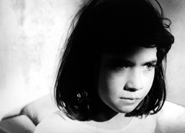Perhaps the most overtly Bressonian of Pedro Costa’s body of work (albeit suffused with the brooding shadows of a Jacques Tourneur film), Costa’s first feature, O Sangue, nevertheless bears the characteristic imprint of what would prove to be his familiar preoccupations: absent parents, surrogate families, unreconciled ghosts, the trauma and violence of displacement, the ache (and isolation) of longing. The thematic convergence is insightfully revealed in an episode that occurs near the end of the film, when the older brother Vicente (Pedro Hestnes), having been held captive by his father’s nefarious associates on New Year’s Eve in a half-baked attempt to collect his father’s unpaid debt from him, awakens in the darkness of an unfamiliar apartment to the sight of a restless silhouette on the balcony – the shadow cast by his father’s mistress (Isabel de Castro) that has been made spectral and incandescent by the transient glow of exploding fireworks and the sweep of wind against translucent curtains (a sense of otherworldliness that also reinforces a captor’s earlier idea of conducting a séance in order to contact Vincente’s missing father). Costa establishes this sinister atmosphere of sudden, erupted violence in the film’s opening sequence: the prefiguring sound of a slammed door and scurrying feet that subsequently reveals a frontal shot of Vicente on a muddy road as he is suddenly slapped by his wayward father while intentionally blocking his path, trying to prevent him for leaving by imploring him to show consideration towards his younger brother Nino (Nuno Ferreira) who has been left home alone in the middle of night in pursuit of him. Cutting to the image of Vicente riding his scooter through the empty streets at twilight, and subsequently, the schoolteacher, Clara’s (Inês de Medeiros) realization that a student, Rosa (Sara Breia) has run away from school with Nino, the image of dislocation and fugue also becomes a resurfacing idea, a reflection of the characters’ own desire to reinvent and transform in the aftermath of loss that is reflected in Nino’s impulsive attempt to rearrange the furniture, and his subsequent request to similarly dress Vicente in his clothing while accompanying him to school after their father’s disappearance (a longing for change that is also implied in Clara’s selection of a new haircut for Nino). However, when Vicente and Nino’s skeptical uncle (Luís Miguel Cintra) pays a visit and finds the brothers home alone on Christmas Eve with Clara, his heavy-handed, if well-intentioned decision to take Nino away from home and form a new family with his fragile son Pedro (Miguel Fernandes) would lead the brothers into their own journeys of self-discovery in their isolated quest to return to their broken home.
It is interesting to note that in illustrating the brothers’ (as well as Clara’s) subverted attempts at escapism (and figurative erasure) – the persistence of a haunted past (an apparent allusion to Tourneur) that is ingeniously reinforced in the discovery of a body on the lake near the fairgrounds where Vicente and Clara go on a date – Costa introduces the idea of an irrepressible, hidden history that continues to haunt present-day consciousness. Costa expounds on this theme of place as the eternal witness to a deracinated history in evoking Cape Verde’s tragic legacy (as leprosarium and slave port) in the moral contamination of the forgotten residents in Casa de Lava, as well as the concentration camps of Tarrafal (in Tarrafal and The Rabbit Hunters) that perpetuate a sense of moribund captivity to a contaminated, dying land. Similarly, the contrast between the abandoned, rural family home and the sterile, anonymous apartment buildings where the brothers are held against their will in O Sangue may be seen as a prefiguration of the Fonthainas diaspora itself, from the transitory sanctuary embodied by dilapidated, condemned spaces (In Vanda’s Room), to the soullessness of uprooted communities represented by impersonal, high density, public housing (Colossal Youth). In this respect, Vicente and Nino’s instinctual struggle to escape also represents a moral captivity to a traumatic history, an elusive homecoming that paradoxically embodies both liberation and surrender to the will of fate.
© Acquarello 2008. All rights reserved.
